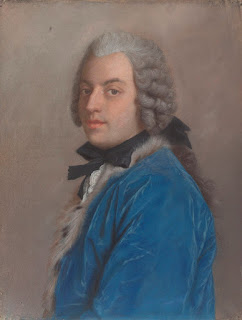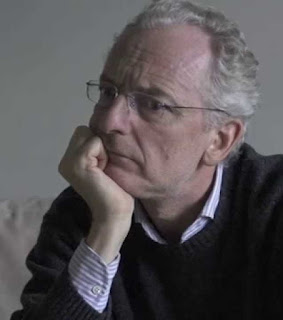 |
| Francesco Algarotti was a man of many talents with a colorful love life |
Philosopher and polymath with a playboy lifestyle
The multi-talented writer, philosopher and art connoisseur Francesco Algarotti, one of the most prominent and colourful individuals in 18th century intellectual society, died in this day in 1764 in Pisa.
Algarotti, who wrote many essays and a number of books, was something of a polymath in his breadth of knowledge on a wide number of subjects, including architecture and music as well as art. He was also a charismatic figure who became friends with most of the leading authors of his day, including Voltaire, Jean-Baptiste de Boyer, Marquis d'Argens and Pierre-Louis de Maupertuis.
His urbane manner and suave good looks, combined with his considerable intellect, led him to acquire admirers of both sexes. Indeed, at one time he is said to have found himself at the centre of a colourful bisexual love triangle involving John Hervey, the English peer and politician, and Lady Mary Wortley Montagu, the aristocratic travel writer, who became infatuated with Algarotti at the same time as Hervey, her one-time lover.
Algarotti was often engaged by the courts of European monarchs to acquire or commission paintings and other decorative artworks, or to advise on architectural projects, but also amassed a considerable collection of his own. He commissioned works by Tiepolo, Pittoni, Piazzetta, Castiglione, Panini and Balestra among others, while helping to further the careers of Giuseppe Nogari, Bernardo Bellotto and Francesco Pavona.
 |
| Lady Mary Wortley Montagu is said to have become infatuated with Algarotti |
One painting thought to have been in his collection, Sebastiano Ricci’s Vision of St Bruno, sold at auction in the United States for $500,000 after turning up in a warehouse in Texas in 2008.
Algarotti was born in Venice in 1712. His father, a wealthy merchant, was an art collector and it was expected he would join his older brother, Bonomo, in the family business.
Instead, he went Rome to for a year, and then studied natural sciences and mathematics at Bologna and Florence. At age of 20, he went to Paris, where he became friendly with Voltaire and, in 1737, published Newtonianesimo per le dame, ovvero Dialoghi sopra la luce e i colori (Newtonianism for Ladies, or Dialogues on Light and Colour), a work on Newtonian optics, in which he had a particular expertise.
He spent time in London, where he met Lord Hervey, who would later become Lord Privy Seal in the government led by Robert Walpole. Hervey, who is known to have had many affairs with both men and women, was drawn towards his sophistication and physical attractiveness, but at the same time Algarotti attracted the attention of Lady Mary Wortley Montagu, who became so enamoured of him that she left her husband and proposed that they live together in Italy.
| Algarotti's tomb, paid for by Frederick the Great, at Campo Santo in Pisa |
A member of the Royal Society, Algarotti was popular in many European courts. Frederick the Great made him a Prussian count. Augustus III of Poland also honored him with the title of Councillor.
In 1754, he returned to Italy, living in Bologna, Venice and then Pisa, where he died from tuberculosis ten years later at the age of 51. In his memory, Frederick the Great erected a monument to him on the Campo Santo in Pisa.
Algarotti's writings include several studies on classical themes and a series of treatises on language, opera, architecture, the poet Horace, painting and on influences on national character. He is credited with introducing the genre of essay-writing into Italy.
His 1745 book Il congresso di Citera, which was published in English as The Modern Art of Love, was a lighthearted comparison of English, French, and Italian attitudes toward love.
 |
| Panini's painting of the interior of The Pantheon in Rome |
The Pantheon in Piazza della Rotonda in Rome is considered to be Rome’s best preserved ancient building. It was built in AD 118 on the site of a previous building dating back to 27 BC. It was consecrated as a church in the seventh century and many important people are buried there, including Victor Emmanuel II, his son, Umberto I, and his wife, Queen Margherita. It was as much a tourist attraction in Panini’s day as it is today and Panini manipulated the proportions and perspective to include more of the interior that is actually visible from any one vantage point.
 |
| The Campo Santo is part of the Piazza dei Miracoli complex, the most famous landmark of which is the Leaning Tower |
The Campo Santo, also known as Camposanto Monumentale, is a huge oblong Gothic cloister at the northern edge of the Piazza dei Miracoli in Pisa. Designed by Giovanni di Simone, who began work on it in 1278, it was the fourth and final structure erected in the piazza, following the cathedral, the baptistery and the campanile - the leaning tower. It is thought the building was not meant to be a cemetery, but a church called Santissima Trinità (Most Holy Trinity), but the project changed during construction. It is called Campo Santo, which literally means ‘holy field’, because it is said to have been built on sacred soil from Calvary, or Golgotha, the site outside the walls of Jerusalem where the Gospels say Christ was crucified, which had been brought back to Pisa from the Third Crusade by Ubaldo Lanfranchi, archbishop of Pisa.
More reading:
Panini's eye for capturing scenes of Rome
Tiepolo's legacy to Venice
How 18th century Venetian playwright Carlo Goldoni reinvigorated commedia dell'arte
Also on this day:
1461: The birth of patron of the arts Cardinal Raffaele Riario
1469: The birth of statesman and diplomat Niccolò Machiavelli
1815: Austria defeats Napoleon's troops at the Battle of Tolentino
Home









